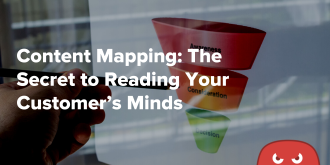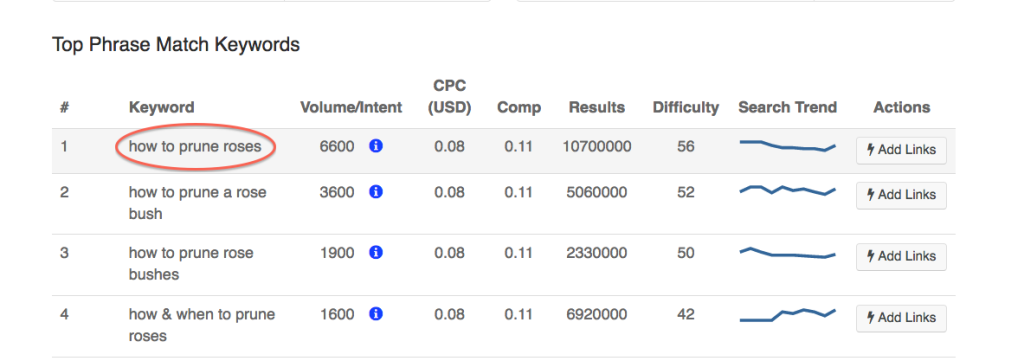Quick Links
Have you put together a content strategy for the year yet? The clock is ticking!
You should know that content remains a pivotal marketing channel in 2024, with 73% of B2B marketers and 70% of B2C marketers using content marketing as part of their overall strategy.
As Insider Intelligence notes, a content strategy is ‘table stakes’ for any business wanting to compete in the digital age.
That’s because content is integral for building brand awareness, connecting with audiences, and generating consistent leads.
However, random content creation won’t cut it (we’re looking at you, ChatGPT addicts).
A successful content strategy takes clear goals, an in-depth understanding of your core audience, keyword research, and high-quality content containing original insights (translation: written by humans).
Additionally, you need to understand what content formats resonate best with your audience – like short-form videos, in-depth blog posts, or something else entirely.
For instance, some audiences will prefer short-form videos on TikTok (younger audiences), while others prefer in-depth blog posts (B2B clients).
With a thought-out content strategy and editorial calendar, nothing will stand in your way from achieving your SEO goals.
Ready to build a winning content strategy in 2024? Stick around to learn how!
What is a digital content strategy?
A content strategy is a type of marketing plan where you create digital content to A) provide value to your target audience, and B) achieve your business goals.
In particular, businesses use content to boost their online visibility via search engine optimization (SEO), build brand awareness with target audiences, and generate leads & conversions.
It encompasses all organic digital marketing channels, like social media, SEO, blogging, video marketing, podcasts, and more.
The types of content used in these strategies include:
- Blog posts
- Podcasts
- eBooks
- Whitepapers
- Infographics
- Social media posts
- Video content
- Webinars
Content creation is a form of inbound marketing, meaning you attract customers to you instead of pursuing them through disruptive ad placements (like interrupting a user’s experience on YouTube with an ad).
An example would be attracting leads to your website by answering common questions they have through your blog posts.
The thinking is that whenever a prospect asks a search engine like Google one of these questions, they’ll come across one of your blog posts.
Another example would be converting prospects with in-depth video content and blog posts that link to your product pages via CTAs (calls to action).
Whatever type of content you use, the idea remains the same – to grow your business and enhance your reputation by consistently creating great content that appeals to your target audience.
Why Bother With A Formal Digital Content Strategy?
We’ll clue you in on an insider secret: a content strategy isn’t just about creating content.
Instead, it’s about creating the right type of content that your audience craves and aligns with your business goals.
For example, you could write a blog post that A) answers a question the user has been searching for and B) directs them toward one of your products that will solve their problem forever.
Content creation is also powerful because it’s a reliable and cost-effective way to consistently generate organic traffic to your website. If your landing pages are optimized for conversions, you’ll boost your sales and lead generation efforts along the way.
However, you need to stay organized, or the whole thing will fall apart.
Here’s a look at the benefits of taking the time to form an in-depth digital content strategy.
Benefit #1: Clarity & Focus
- It eliminates guesswork: A strategy outlines your audience, goals, and what content will help you achieve those goals.
- A strong strategy aligns the team: Everyone knows what needs to be done and why, promoting efficiency and collaboration.
Benefit #2: Improved Results & ROI
- Targeted content: Your efforts will place your content in front of the right people at the right time, increasing the likelihood of conversions.
- Data-driven decisions: With tracking and analysis built into your strategy, you’ll optimize what works and cut what doesn’t, maximizing your ROI.
Benefit #3: Building Brand Authority
- Consistency builds trust: A cohesive brand voice and high-quality content position you as a knowledgeable and reliable authority figure in your field. Consistent efforts will help you achieve the coveted and much sought-after thought leader status.
- Thought leadership: Become a go-to source of information in your industry. Thought leadership blogs are relatively inexpensive to produce, and they can yield impressive results. In fact, 55% of brands gain new clients thanks to their blogging efforts, and marketers that prioritize blogging see a 13x higher ROI than those who do not.
Benefit #4: Increased Efficiency & Consistency
- Content calendars save time: With a detailed content calendar, you won’t be scrambling at the last minute to come up with posts.
- Repurposing power: A single strong piece of content can be adapted into multiple formats like infographics, blogs, and videos.
Benefit #5: Competitive Advantage
- Stand out from the noise: A well-executed strategy helps you outshine competitors who are simply winging it (the chances are there are many).
- Adaptability: Your strategy allows you to respond to industry shifts and pivot when needed.
How to Develop a Digital Content Strategy in 10 Steps
Consistently knocking it out of the park with outstanding content for your audience is definitely easier said than done.
That’s why you need to know the core components of a winning content strategy.
Whether you’re sitting on a vast content library or are about to sit down to write your first blog, these 10 steps will teach you how to develop a content strategy from scratch.
#1: Audit your existing content
Before you do anything, you need to know where you stand SEO-wise, which means auditing the content you’ve already published to ensure it’s properly optimized.
This step won’t apply if you don’t have existing content on your website. However, it will apply once you’ve accrued a library of content, as regular audits are necessary for a healthy SEO profile.
Here’s what a thorough content audit entails:
- Understand your audience’s preferences. Diving into your analytics will help you realize which types of content receive the most engagement and shares. Take notes on what your audience finds valuable and aim to produce similar types of content in the future.
- Identify outdated content. If some of your content is no longer accurate or relevant, it will only hurt your user experience and credibility. Create a list of aging content that needs updating to become relevant again.
- Find content gaps. Do you have a well-rounded content library that touches on all aspects of your business, or are you oversaturating one topic?
- Keyword optimization. During the content audit, pay attention to the target keywords (if any) for each post. If your older posts aren’t specifically targeting relevant keywords, edit them so that they do.
- Goal alignment. A content audit will also let you know if the content you’re currently producing is inching you closer to your current goals or not.
To summarize, a content audit bolsters your overall content strategy by discovering what works, removing what doesn’t, and making sure all your content pieces work together as a cohesive whole.
#2: Clearly define your content goals
A winning digital content strategy begins with a crystal-clear understanding of what you want to achieve for your business. Don’t fall into the trap of vague goals.
Here’s an example of a poorly defined goal:
To achieve higher SERP rankings and generate more revenue.
This goal is far too scarce on essential details like a timeframe and specific targets to hit.
Here’s a better version of the same goal:
To rank in the top 5 for our target keyword and increase revenue by 2x in 14 months.
By now, the goal has some specifics you can sink your teeth into when developing the rest of your strategy. You know that you want to rank within the top 5 and see a twofold increase in revenue, and you’re giving yourself 14 months to make it happen.
Not only will this better inform your overall content strategy, but it will also give you clear metrics to measure your success.
#3: Develop a customer avatar
Next, you need to get inside the heads of your target audience to better understand how they behave as consumers.
How do you do that?
The best way is to create a detailed customer avatar (aka buyer persona), which is a consumer profile representing one of your typical audience members.
Your customer avatar needs the following:
- A Name
- Age
- Occupation
- Interests
- Hobbies
- Consumer habits
- Pain points
Feel free to get as detailed as you want with your avatar, as you can even include a picture if that helps you. The purpose of a customer avatar is to understand what your potential customers want and how they think.
That will make it far easier to develop relevant content ideas that will appeal to them, which will help you achieve your content goals.
Creating a customer avatar requires lots of research. In particular, you need to read and analyze:
- Customer interviews. Sit down and talk with your customers to peer inside their minds. What makes them get up in the morning? Are there any specific things that attracted them to your brand?
- Surveys. Customer surveys are another great way to get in touch with your audience, specifically about the things they like/don’t like.
- Product reviews. What do past customers have to say about your products and services? Looking up third-party reviews is an effective way to learn more about your target audience.
| Expert insight: Use data to create your buyer personas
Social media analytics provide rich data for developing customer avatars. Facebook Audience Insights is particularly helpful. Google Analytics also reveals which social channels your audience prefers. This insight is crucial, as it guides where you should focus your content distribution. For example, if your analytics show a strong audience presence on LinkedIn, prioritize sharing your blogs and videos on that platform. |
#4: Assemble a content creation team
How do you plan on creating all the content you need for your strategy?
This is a question you need to ask yourself before you go any further with your content plans.
You’ll need to decide how much content you’ll create by yourself (if any), how much your in-house team will handle (if you have one), and how much you’ll outsource to freelancers/automate with AI.
If you plan on tackling some of the content yourself, do a ‘test run’ to see if it’s realistically feasible with your schedule (content creation is notoriously time-consuming, so beware).
If not, consider services like iWriter and UpWork, as they’re excellent resources for finding freelance content creators – including writers, editors, graphic designers, web developers, and more.
You may also need to hire videographers and video editors for your video content, or you can choose to film it in-house. It’s crucial to work out the logistics of your videos before shooting to determine if you need elaborate production or if winging it with an iPhone and Windows Movie Maker can work.
Publishing content can also be a challenge if you don’t have experience. If you don’t know how to upload content to a CMS (content management system) like WordPress, you’ll need to hire a freelancer to handle that for you as well.
#5: Gather the necessary tools and resources
A well-planned digital content strategy isn’t just about the content itself; it’s about having the right tools to streamline the process.
Here’s a look at what you’ll need at each step of the way:
| Category | Subcategory | Tools |
| Planning & Goal Setting | Project Management | Asana, Trello, Monday.com |
| Mind Mapping | MindMeister, XMind, Coggle | |
| Editorial Calendars | CoSchedule, Google Sheets/Calendar, Airtable | |
| Research & Analysis | Keyword Research | SEMrush, Ahrefs, Moz, Google Keyword Planner |
| Competitor Analysis | BuzzSumo, SimilarWeb, SpyFu | |
| Audience Insights | Facebook Audience Insights, Google Analytics, Sprout Social | |
| Content Creation | Writing & Editing | Microsoft Word, Google Docs, Grammarly, ProWritingAid |
| Graphic Design | Canva, Adobe Creative Suite (Photoshop, Illustrator), Visme | |
| Video Production | Adobe Premiere Pro, Final Cut Pro, iMovie, Kapwing | |
| Audio Production | Audacity, GarageBand, Adobe Audition | |
| CMS | WordPress, Squarespace, Wix, Drupal, Joomla | |
| Distribution & Promotion | Social Media Management | Hootsuite, Sprout Social, Buffer |
| Email Marketing | Mailchimp, ConvertKit, ActiveCampaign | |
| Content Syndication | Medium, LinkedIn Pulse, industry-specific sites | |
| Measurement & Analytics | Website Analytics | Google Analytics |
| Social Media Analytics | Native analytics within Facebook, X, LinkedIn etc. | |
| SEO Tools | SEMrush, Ahrefs, Moz |
| Key point: Creating content with the aid of tools isn’t cheap, so you’ll need to determine your budget. From project management software to SEO analytical tools, the price tag can add up quickly. Before you rack up a price you can’t afford, factor in potential costs not only for tools but also for hiring freelancers. That way, you’ll always know how much you’re spending and on what. |
#6: Conduct SEO keyword research
Once you’ve got your team and tools in place, it’s time to start conducting keyword research – not only for SEO purposes but also to guide your content strategy in the right direction.
Keywords or search queries are what your target audience types into search engines to find information about products and services related to what you do.
By uncovering and targeting these keywords, you’ll not only appeal to search engines, but you’ll also better understand the types of content your target audience is looking for the most.
It always helps to consider an example, so let’s say you sell gardening tools online.
After doing a little digging using our free keyword planner tool, you land upon the long-tail keyword ‘how to prune roses.’
It has a high search volume and an upward trend, which means ranking for it will benefit your SEO profile. In addition, the keyword provides a hint at which type of content you should produce for it.
Since it’s clear that lots of people want to learn how to prune roses (and the keyword has informational intent notated by the blue lowercase ‘i’), developing a how-to guide or tutorial in either video or blog format is the way to go.
Ideally, your piece of content will begin to attract organic visitors eager to learn how to prune their garden roses properly. With a well-placed CTA or lead magnet, this helpful how-to guide will start generating sales & leads for your business.
That’s a brief and idealistic breakdown of keyword research, but the principle is there. You need to identify trending keywords in your niche to create content for, and our free tool can help with that.
#7: Brainstorm content ideas for your keywords
Once you have at least two to three keywords to target per piece of content, you can start brainstorming ideas for them.
Pay attention to the intent behind the keyword, as that will provide clues to what type of content you should create. Is it informational? Then, you should consider blog posts, guides, and how-to posts. If it’s commercial, product reviews and free demos are the way to go.
Ultimately, it’s up to you to decide what to produce, but you should base your decisions on your research.
Let’s say you own a gardening accessories store and want to promote your gardening hoes.
A quick look at our free keyword planner might initially discourage you – the term “how to use a garden hoe” seems to be on a downward trend.
However, a gem emerges: “hoe garden tool” has a much better trend. Also, this has commercial intent – as signified by the tiny skyscraper next to it
This means the user is actively comparing gardening tools, which gives you the chance to land a conversion if your content is convincing enough.
Content ideas:
Blog: A blog post like “The Top 10 Hoe Garden Tools You Must Try” is perfect for this keyword. Review a mix of popular tools, including your own. Call-out boxes and a compelling CTA naturally promote your product.
Video demo: Consider a short video demonstrating the effectiveness and unique features of your gardening tool. Share it on YouTube and social platforms where how-to searches are common.
Infographic: Create a visually appealing infographic comparing different garden hoe types (draw hoe, scuffle hoe, etc.). Include the pros, cons, and best uses of each, all while subtly highlighting your own product’s strengths.
Key takeaway: Let trending keywords guide your content types. Pay close attention to the search intent behind the terms to ensure your content meets the searcher’s needs.
Other things to consider:
➡️Audience: Factor in your target audience’s age, online habits, and preferred platforms. Younger audiences might respond best to short, engaging videos on TikTok as opposed to blog posts on LinkedIn (which are better for B2B decision-makers).
➡️Goals: Are you aiming for brand awareness, product education, or direct sales? This influences content type.
➡️Repurposing: Can a single piece of core content (like a blog post) be adapted into social posts, a short video, or an infographic?
➡️Experiment: Don’t be afraid to try different formats. Tracking engagement helps you refine your choices over time.
#8: Create a content roadmap
By now, you should have a list of relevant keywords and content ideas to go along with them.
Yet, you still need to map out your path to victory via a content roadmap.
A content roadmap is a detailed, visual timeline that outlines your planned content initiatives.
It’s a centralized, ‘living’ document that guides your content strategy, not just a list of topics you want to cover.
A content roadmap is usually a spreadsheet that includes the following:
- Content titles and topics
- Target keywords
- Content formats (blog posts, videos, social media, etc.)
- Publication dates or deadlines
- Responsible team members
- Distribution channels (blog, social media, email, etc.)
- Metrics and KPIs to track success
Why is a content roadmap important?
Alignment: A content map ensures that every piece you produce supports your overall business goals. It keeps everyone on your team working towards the same objectives, which is a plus.
Organization: Content maps reduce chaos, which most organizations have an abundance of already. It also provides structure for content planning, assigning tasks, and staying on schedule.
Accountability: The map clarifies ownership of each content piece and its deadlines.
Adaptability: While a roadmap provides a plan, it also allows for flexibility as you track results and make adjustments based on audience engagement.
Long-term vision: A content roadmap helps you see the big picture and spot gaps or overlaps in your content calendar.
You should aim for a mix of evergreen and timely topics to achieve the best of both worlds. While your evergreen pieces continue to put in work for you, your timely pieces will ensure you capitalize on massive spikes of traffic that occur from reporting on buzzing topics.
| What is evergreen content?
It’s a piece of content that doesn’t go out of date, meaning that the information it provides will stay true forever. Examples include:
These are all topics that won’t expire, so if you’re able to generate traffic and leads with them, they’ll continue to put in work for months and years to come. |
If you focus entirely on producing evergreen content, you’ll miss out on these traffic spikes – which can mean missing out on potential revenue and boosted brand awareness.
When forming your release schedule, ensure that you’re blogging at least 2 – 4 times a week to see the best results.
You should also factor in niche holidays that matter to your target audience, as publishing content around these events can help you generate more traffic and build a loyal following.
Want to learn more about content roadmaps? Check out our comprehensive guide to content mapping now.
#9: Create and publish content
Now that all the prep work is done (yeah, it’s a lot), you can finally start creating and publishing your own content.
Along the way, keep an eye on your project management tools to ensure everything is going smoothly.
Make sure that your content creation team knows when each piece is due to keep things running smoothly. Also, do your best to provide them with supplementary information like outlines, style guides, and detailed instructions.
#10: Analyze data & monitor progress
While content marketing and SEO take time to start gaining traction, you should keep an eye on essential metrics and key performance indicators as soon as possible.
That means checking Google Analytics and Google Search Console to monitor your SERP rankings, organic traffic, and conversion rates.
If you don’t see the results you want within a few months, it’s a sign that you need to go back to the drawing board and try something else.
Common Digital Content Strategy Mistakes to Avoid
Mistake #1: Quantity over Quality
Some site owners are too eager to fill up their websites with lots of content, causing them to go for quantity over quality.
However, this is a mistake because thin, poorly thought-out content dilutes brand messaging, fails to engage readers, and hurts search rankings.
Patience is a virtue here, so focus on creating fewer, higher-quality pieces instead of going ham with AI-generated content.
Mistake #2: Neglecting SEO
Creating content isn’t just about providing value to your target audience (although that should be goal #1). Search engine optimization exists for a reason, so you don’t want to neglect SEO’s role in the process.
That means you must dive into thorough keyword research, utilize a proper site structure, and build high-value links from trusted websites.
Mistake #3: Ignoring your audience
You should never create a piece of content on a whim because it’s what you think your audience wants. Even if you’re extremely familiar with your audience, every piece of content requires in-depth research to ensure it’s viable.
Otherwise, you risk lowering your engagement, missing opportunities for lead generation, and forming a disconnect between your brand and its potential customers.
Mistake #4: Not creating content for every stage of the sales funnel
Content plays a crucial role at each step of the buyer’s journey, so you shouldn’t limit your focus to only one stage of your sales funnel.
Why is that?
It’s because only focusing on one stage will cause you to miss out on potential leads and conversions.
For instance, some businesses only create content for prospects at the bottom of the funnel (BOFU), which is content that aims to convert. While scoring conversions is always great, this technique fails to cater to prospects who aren’t ready to make an immediate purchase.
That’s why you need to produce content for each stage of your sales funnel. Here’s a quick breakdown of what that looks like:
➡️TOFU (top-of-the-funnel): At this stage, the prospect is looking for information, usually to educate themselves by answering a question. Content types include informative blogs, videos, and infographics.
➡️MOFU (middle-of-the-funnel): By now, the prospect wants to learn more about your products and services. Content types for this stage include product videos, nurturing emails, eBooks, and webinars.
➡️BOFU (bottom-of-the-funnel): This is where the prospect is ready to make a purchase; you just have to convince them that you’re the best. BOFU content includes glowing reviews & testimonials, product demo videos, and blog posts that link to product pages.
Understanding the distinct needs of potential customers at each stage will ensure you reach all your prospects, not just the ones looking for information or making a purchase.
Putting Together a Digital Content Strategy That Works for You
That’s what it takes to develop a successful digital content strategy for any business.
As long as you base all your decisions on informed research, develop a content roadmap, and monitor your progress, you shouldn’t have trouble getting a winning content strategy off the ground.
Ready to take your content to the next level?
Let the experts at The HOTH do the heavy lifting. Our managed content services deliver a data-driven content strategy, granting you the freedom to focus on growing your business.
Then look no further than our managed content services at The HOTH. Our team of digital marketing & SEO gurus will provide a winning digital content strategy for you so you can focus on running your business.














Good article Rachel. I’ll come back to this and use suggestions from you to build into our best practices. Thanks for sharing.
Hey Curt,
Awesome. If you need any help, you know where to find us.